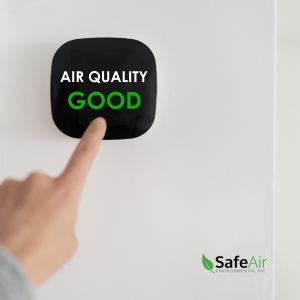Common Indoor Air Pollutants You Need to Know About
Posted in Air Quality, on May 13, 2024
At SafeAir, helping families create healthy indoor air quality is our priority. Beyond the well-publicized dangers of smoking indoors, most folks don’t consider air quality when reviewing safety at home and may miss or underestimate their risk. Home air quality testing is a valuable tool that you can use to measure and assess indoor pollution, particulates, and allergens. Our homes are supposed to be a safe retreat from the busyness of work and school, but indoor air pollution can have a creeping effect, impacting the quality of your rest, concentration, skin, comfort, and more. In today’s article, the SafeAir team will share five of the most common indoor air pollutants inside homes.
Dust and Allergens
 Dust and other allergens are inescapable, but your home or choices may affect their concentration or amount. Dust is comprised of small particles of dirt, skin, or other matter created from your body, clothing, furniture or activities. Domestic dust is often caused by the waste from dust mites, microscopic insects that consume shed human skin cells. Many people are allergic to dust mites, which live in dark and humid places like beds, couches, and soft furnishings.
Dust and other allergens are inescapable, but your home or choices may affect their concentration or amount. Dust is comprised of small particles of dirt, skin, or other matter created from your body, clothing, furniture or activities. Domestic dust is often caused by the waste from dust mites, microscopic insects that consume shed human skin cells. Many people are allergic to dust mites, which live in dark and humid places like beds, couches, and soft furnishings.
Other allergens found in dust may come from nearby industries, roads, or agriculture; pollen during the spring and fall is also a common household pollutant.
Reducing dust is easy: regular cleaning, strategically opening/closing windows, or increasing air flow are all things you can do immediately. Through air quality testing SafeAir can help you create a targeted plan that addresses your home’s specific allergens.
Mold and Mildew
Mold is a fungus that grows indoors on wood, textiles, or paper. It produces small airborne spores that can be detected during home air quality testing — these spores can also cause allergic reactions like sneezing, itchy eyes, and headaches.
Indoor mold growth is widespread and infestations are sparked by an excess of indoor moisture. Often that can be from an accident (like a leak or flood), or use (such as a poorly ventilated bathroom). Regardless of the cause, SafeAir can detect hidden or newly formed mold colonies during testing — and with mold, early detection is vital to avoiding adverse health effects and potential damage to your home.
Volatile Organic Compounds (VOCs)
Everyone knows what a VOC is: imagine cutting open a lemon. The fresh scent of zest is an excellent example of a Volatile Organic Compound, an organic chemical that becomes airborne (volatile) when exposed to room temperature.
Of course, if every VOC were as safe as lemons, we wouldn’t share them on this list. VOCs are often chemical compounds added or created by household materials like cleaning solutions, glues, varnishes, paints, and more. Like zest, these VOCs are also easy to breathe in but may not have as pleasant a reaction — they can cause respiratory or ocular irritation and inflammation, as well as allergic reactions.
The SafeAir team’s primary advice for reducing VOCs indoors is to use unscented products or choose materials labelled low-VOC. Otherwise, increasing ventilation when renovating or painting will go a long way in reducing these harmful chemicals.
Carbon Monoxide
CO is a colourless, odourless, and tasteless gas produced by combustion. If you have a gas furnace, stove, or wood-burning fireplace, your home may be at risk from this gas. All it takes is a minor malfunction to cause CO to build up, and without any way of sensing it with your body, installing a carbon monoxide detector is critical for your family’s health and safety.
Additional safety tips we recommend are using barbecues or idling cars far away from open windows or intake fans, which can pull CO into the home. Symptoms of CO poisoning include lethargy and confusion, making it challenging to recognize when you are the one affected; if you’re concerned about a gas leak or have symptoms of CO poisoning, move into fresh air and seek medical attention immediately.
Radon Gas
Like carbon monoxide, radon gas is impossible to detect with the senses. It comes from deep within the earth where it is produced by decaying uranium. Radon enters homes through basements and foundation cracks or gaps. Long-term exposure to radon gas is the second-most leading cause of lung cancer after cigarette smoking — making it a critical health concern for all Canadians.
SafeAir has several informative articles about radon testing your home — visit our blog to learn more about this deadly invisible gas.
Reduce Indoor Air Pollutants Today
Many homeowners think that air pollution is exclusive to the outdoors — or that it’s time to test when there’s a strange smell. However, as you can see from pollutants like carbon monoxide or radon gas, the deadliest problems often have no scent or create any physical disturbance. Indoor air quality is the foundation of a healthy home and should never be ignored! To learn more about SafeAir, home air quality testing, radon testing, or more, contact our team today.

